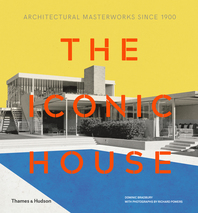Architect Katy Barkan’s renovation-expansion of a 1940s bungalow in Los Angeles is full of nuanced paradox. Like the attention-catching rays of an asterisk, the crisp, radiating lines of her addition—its roof ridges and troughs—converge mid-facade, where the house’s existing and new sections meet. Yet the extension is also quiet, almost deferential: a pale-gray monolith that picks up the low-rise cadence of this residential streetscape. “It simultaneously stands out and fits in,” says Barkan, who teaches architectural design at UCLA. With this inaugural project of her firm, Now Here, she has embraced the language of Los Angeles’ ubiquitous, modest single-family house, yet deftly subverted it, engaging its material palette and construction methods while nimbly tweaking its familiar forms.
The result is “1/2 House.” Or perhaps it should be called half-and-half house—or one/two house, since its exterior composition toggles between being one volume or two. The original Monopoly-piece bungalow and its side-by-side addition—both stucco-clad, balloon-frame construction with asphalt-shingled pitched roofs—merge compatibly, while remaining distinct in color, form, and character. Most striking is the new roof’s inversion, with its V-shaped valley, instead of a peaking ridge. This geometric feat—almost imperceptibly sweeping up into a new second story toward the back—allows for vertical expansion (plus excellent drainage) without disrupting the streetscape’s scale and gabled rhythms. The new facade essentially ends in half a gable (inspiring the name “1/2 House”), gesturing toward the upswing of the neighboring peak.
The composite facade of the original bungalow—now charcoal-colored and pared down in its details—with its lighter-gray counterpart has a solidity that makes the experience of crossing the threshold quite unexpected. The newly centered front door opens into a soaring, luminous space: there, daylit from above, the house’s two parts are joined by a rift—as if the overlap of two solid forms resulted in a lozenge-shaped area of glowing transparency.
“We wanted to draw in the feeling of the front stoop, where we’ve always hung out with our neighbors,” says Dev Larks, a nurse (and Barkan’s sister), who commissioned the project with her husband, Roosevelt Larks, a TV-industry grip and voice-over actor. “Our door is rarely closed. We love to entertain.”
Now the interior space, and breezes, flow from the entrance, across the open kitchen and slightly skewed living room, out through sliding glass doors to the backyard and swimming pool. (The living room had to veer off the orthogonal to provide code-required clearance for the existing freestanding garage at back, currently used as a cabana—but that modest bend in plan gives the rear of the house more privacy.) The master suite is on the ground floor, beneath the inverted roof, and, upstairs, toward the yard, bedrooms for the couple’s two teenage daughters share a lounge overlooking the main living areas.
“That view down was important to us,” says Dev Larks, “even though we expanded our house from 1,150 to 2,400 square feet, we wanted to preserve the sense of being together and connected.”
Since the bungalow’s transformation, she adds, “people often stop their cars, snap photos, and shout, ‘I love your house!’ ” It’s also been a great calling card for Barkan, bringing in work from the neighborhood and beyond.











Post a comment to this article
Report Abusive Comment